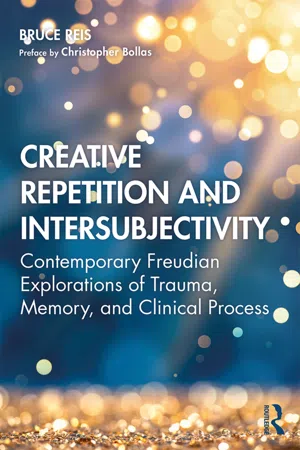subject to a very special state of passivity; he is at the mercy of something that is happening within him … the analyst experiences, witnesses, lives – all words conveying the extent to which he is caught up in this aggravated state of passivity – and undergoes an inner transformation.
(2013, pp. 89–90)
Within this state, the analyst may respond to something the patient hasn’t said, he may experience images within his mind that feel vivid, yet which he has no feeling of responsibility for, or he may see abstract forms or faces that morph into each other. Just as suddenly and usually, after only a brief period of time, the ego may intervene so that
words and sentences insert themselves that can undoubtedly lead to the formulation of interpretations, but also serve to help the analyst get a grip again on the consequences of passivity. The protagonists then find that acceptable boundaries have been re-established.
(p. 91)
In his chapter ‘Invitation to Frequent the Shadows’, de M’Uzan (2006, pp. 161–162) presents several examples of clinical moments in which the boundary of identity between patient and analyst may be experienced as in flux. In a 1994 report on a more pedestrian form of this phenomenon, resulting from the paradoxical thoughts of the analyst De M’Uzan begins by observing that there was little he found especially disquieting about his patient who had been in analysis for several years. At the end of the session prior to the one he concentrates on, the patient left in an unusual way, saying to her analyst, ‘Au revoir, Monsieur’. Her associations to this phrase during the next session provoked a memory that the patient had ‘more or less forgotten’. The memory was from when the patient was 2-and-a-half years old and is reported as follows: She had been walking along the street when suddenly she found herself in the police station. The policemen made her stand on a table and were questioning her. In listening to the patient’s memory, de M’Uzan experienced a sense of depersonalization, which he described as a background experience from which his paradoxical thoughts emerged into consciousness. Then ‘an unusual thought came to my mind: I would happily gobble you up, you handsome sailor’. De M’Uzan did not share this surprising thought with his patient or make an interpretation, he simply noted to himself the association, which relates to Billy Budd, the hero of a Herman Melville short story he had read years before, and which he felt intuitively was connected to the ‘monsieur’ of the patient’s farewell. Later on, he remembered that it is customary in the British or American Navy to address officers as ‘sir’. As he was having these thoughts, the patient continued to recount her childhood memory. At the police station, she felt intense shame, and she stressed the peculiar quality of her experience. Then she saw her Uncle Pierre enter. The patient then shifted to talking about a dream she’d already told the analyst, but which he felt ‘for some obscure reason … [he] wanted to hear again’. In the dream, there was a slab of stone covered in black fabric that reminded the patient of a tombstone and a table. The patient’s father had once offered her a marble-topped table. The patient said she wanted to get rid of that table and replace it with another that she would choose herself: a dining table (‘table à manger’). Then the patient started talking about food, telling the analyst about a local dish from her country of origin she strongly disliked: ‘And yet’, she insistently added, ‘j’étais de bonne composition’ (i.e. ‘not fussy’). Once again, the analyst experienced an alteration in his thinking and without evaluating the logic of the sequences, he replied, ‘In saying ‘de bonne composition’, perhaps you mean ‘bon à manger’! (‘good to eat’). Taken aback, and seemingly a little worried, the patient replied, ‘Yes, it’s true! I am thinking again now of that Uncle Pierre who used to frighten me so much. He used to say to me: ‘I’m a lion; I’m going to eat you. I was fascinated, excited, and terrified’. The next day, de M’Uzan explored his association with Melville’s character, recalling that the patient’s neck had been ‘conspicuously bare on that day’. Billy Budd, nicknamed the ‘handsome sailor’, ended up being hanged from the ship’s main yard, bringing into focus the link between the tombstone and the condemned hero. De M’Uzan reported that
at the end of this phase in the treatment, a repression with its roots in the drives and oral eroticism was lifted, in such a way that it would colour the Oedipal conflicts of the patient, in her past, and also in the actuality of her transference.
De M’Uzan writes that his experience in the session was not a countertransferential interference, as the representations that occurred ‘did not depend specifically on my inner life’. According to the author, neither were they a personal reaction to the patient’s transference. Instead, it was an instance in which the analyst’s psychical apparatus literally became the analysand’s, as it had been invaded and taken possession of so that the patient’s mental process could occur there. By annexing the analyst’s psychical system, the patient sought to be understood through the interposition of her representation. For his part, the analyst withdrew his individual passions and history so his functional capacities could be made use of. ‘Nothing seems so convincing,’ writes de M’Uzan (1999, p. 111), ‘as the sudden appearance of a monster at the heart of what I have called the paraphrenic realm; and this apparition imposes itself decisively, just like a delusional idea, with incomparable clarity’.
